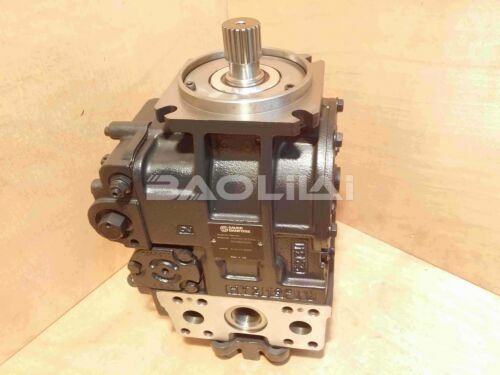The fuel consumption of a plunger pump can vary due to a number of factors
The fuel consumption of a plunger pump can vary depending on a number of factors including pump design, size, operating conditions, efficiency and the power source used. Piston pumps are usually driven by various types of engines, such as electric motors, gasoline engines or diesel engines, which affect fuel consumption differently. Here are some points to consider:
1. Power source: The type of power source used to drive the plunger pump can significantly affect fuel consumption. Electric pumps are generally more energy efficient and consume less fuel than gasoline or diesel powered pumps.
2. Pump efficiency: The efficiency of the plunger pump itself plays a certain role in fuel consumption. A more efficient pump converts more input energy into hydraulic power and requires less energy input, resulting in lower fuel consumption.
3. Working conditions: The working conditions of the plunger pump, such as flow, pressure and duty cycle, will affect fuel consumption. Higher flow rates and pressures generally require more energy, resulting in increased fuel consumption. Long periods of continuous operation or frequent start-stop cycles can also affect fuel efficiency.
4. Pump size and design: The size and design of the plunger pump affects fuel consumption. Larger pumps may require more power to run, resulting in higher fuel consumption. In addition, design characteristics such as internal clearances, hydraulic losses and mechanical friction can also affect the overall efficiency and fuel consumption of the pump.
90-R-055-MA-1-BC-60-S-3-C6-C-03-GBA-35-35-24 90R055MA1BC60S3C6C03GBA353524
90-R-055-MA-1-BC-60-S-3-C6-C-03-GBA-35-35-20 90R055MA1BC60S3C6C03GBA353520
90-R-055-MA-1-BC-60-R-3-S1-D-C5-GBA-23-23-24 90R055MA1BC60R3S1DC5GBA232324
90-R-055-MA-1-BC-60-R-3-S1-C-03-GBA-26-26-24 90R055MA1BC60R3S1C03GBA262624
90-R-055-MA-1-BC-60-R-3-S1-C-02-GBA-35-35-24 90R055MA1BC60R3S1C02GBA353524
90-R-055-MA-1-BC-60-P-3-S1-D-03-GBA-26-26-24 90R055MA1BC60P3S1D03GBA262624
90-R-055-MA-1-BC-60-P-3-S1-C-03-GBA-35-35-24 90R055MA1BC60P3S1C03GBA353524
90-R-055-MA-1-BC-60-P-3-S1-C-03-FAC-35-35-24 90R055MA1BC60P3S1C03FAC353524
90-R-055-MA-1-BC-60-P-3-C6-C-03-GBA-42-42-24 90R055MA1BC60P3C6C03GBA424224
90-R-055-MA-1-BC-60-P-3-C6-C-03-GBA-35-35-24 90R055MA1BC60P3C6C03GBA353524
90-R-055-MA-1-BC-60-P-3-C6-C-03-GBA-26-26-28 90R055MA1BC60P3C6C03GBA262628
90-R-055-MA-1-BC-60-D-3-S1-L-02-GBA-42-42-28 90R055MA1BC60D3S1L02GBA424228
90-R-055-MA-1-BB-60-S-4-S1-C-03-GBA-20-20-24 90R055MA1BB60S4S1C03GBA202024
90-R-055-MA-1-BB-60-S-3-C6-D-04-GBA-42-42-26 90R055MA1BB60S3C6D04GBA424226
90-R-055-MA-1-BB-60-P-3-C6-C-03-GBA-35-35-24 90R055MA1BB60P3C6C03GBA353524
90-R-055-MA-1-BB-60-L-3-C6-D-03-GBA-38-38-24 90R055MA1BB60L3C6D03GBA383824
90-R-055-MA-1-AC-80-S-4-S1-C-03-GBA-35-35-24 90R055MA1AC80S4S1C03GBA353524
90-R-055-MA-1-AB-80-P-4-C6-D-03-GBA-35-35-24 90R055MA1AB80P4C6D03GBA353524
90-R-055-MA-1-AB-80-P-4-C6-C-03-GBA-17-17-20 90R055MA1AB80P4C6C03GBA171720
90-R-055-MA-1-AB-80-P-3-S1-C-03-GBA-29-29-28 90R055MA1AB80P3S1C03GBA292928

5. Maintenance and system optimization: Regular maintenance, including proper lubrication, checking seals and valves, and addressing any leaks or inefficiencies, is critical to maintaining peak pump performance and minimizing fuel consumption. Additionally, system optimization, such as properly sizing the pump to the application and minimizing pressure losses in the system, can help improve fuel efficiency.
6. Control system: Using an advanced control system, such as a variable speed drive or frequency converter, the operation of the pump can be optimized according to the demand. These systems can adjust pump speed or output to match required flow and pressure, improving fuel efficiency by reducing wasted energy.
7. Fuel type: If the plunger pump is powered by a fuel engine, the type and quality of fuel used will affect fuel consumption. Using high-quality fuel, proper fuel filtration, and following the manufacturer's recommendations for fuel type and quality can help optimize fuel consumption.
8. Load curve: The load curve or duty cycle of the plunger pump will affect the fuel consumption. If the pump operates at varying loads or experiences periods of low demand, fuel consumption may be higher during these periods due to inefficiencies associated with operating below the pump's optimum efficiency range. Knowing the load profile and optimizing pump operation can help reduce fuel consumption.
90-R-055-MA-1-AB-61-S-3-S1-D-03-GBA-26-26-24 90R055MA1AB61S3S1D03GBA262624
90-R-055-MA-1-AB-61-S-3-S1-D-03-GBA-26-26-20 90R055MA1AB61S3S1D03GBA262620
90-R-055-MA-1-AB-61-S-3-S1-D-03-GBA-23-23-20 90R055MA1AB61S3S1D03GBA232320
90-R-055-MA-1-AB-61-R-3-S1-D-03-GBA-35-35-24 90R055MA1AB61R3S1D03GBA353524
90-R-055-MA-1-AB-61-R-3-C6-D-03-GBA-35-35-24 90R055MA1AB61R3C6D03GBA353524
90-R-055-MA-1-AB-60-S-4-S1-C-03-GBA-38-38-20 90R055MA1AB60S4S1C03GBA383820
90-R-055-MA-1-AB-60-S-4-C6-C-03-GBA-38-38-24 90R055MA1AB60S4C6C03GBA383824
90-R-055-MA-1-AB-60-S-3-S1-D-03-GBA-42-42-24 90R055MA1AB60S3S1D03GBA424224
90-R-055-MA-1-AB-60-S-3-S1-C-03-GBA-42-42-24 90R055MA1AB60S3S1C03GBA424224
90-R-055-MA-1-AB-60-S-3-S1-C-03-GBA-38-38-24 90R055MA1AB60S3S1C03GBA383824
90-R-055-MA-1-AB-60-S-3-S1-C-03-GBA-35-35-24 90R055MA1AB60S3S1C03GBA353524
90-R-055-MA-1-AB-60-S-3-S1-C-03-GBA-26-26-20 90R055MA1AB60S3S1C03GBA262620
90-R-055-MA-1-AB-60-S-3-S1-C-03-GBA-17-17-24 90R055MA1AB60S3S1C03GBA171724
90-R-055-MA-1-AB-60-S-3-S1-C-02-GBA-42-42-24 90R055MA1AB60S3S1C02GBA424224
90-R-055-MA-1-AB-60-S-3-C6-D-04-GBA-35-35-24 90R055MA1AB60S3C6D04GBA353524
90-R-055-MA-1-AB-60-S-3-C6-C-04-GBA-42-42-28 90R055MA1AB60S3C6C04GBA424228
90-R-055-MA-1-AB-60-S-3-C6-C-03-GBA-42-42-20 90R055MA1AB60S3C6C03GBA424220
90-R-055-MA-1-AB-60-S-3-C6-C-03-GBA-35-35-20 90R055MA1AB60S3C6C03GBA353520
90-R-055-MA-1-AB-60-S-3-C6-C-03-GBA-26-26-20 90R055MA1AB60S3C6C03GBA262620
90-R-055-MA-1-AB-60-S-3-C6-C-02-GBA-42-42-24 90R055MA1AB60S3C6C02GBA424224
9. Energy recovery: In some applications, energy recovery systems can be implemented to reduce fuel consumption. These systems capture and reuse energy that would otherwise be wasted, for example through heat recovery or reduced pressure. By recovering and utilizing this energy, the overall fuel consumption of the piston pump can be reduced.
10. System Design Optimization: The overall system design and configuration will affect fuel consumption. Proper sizing of pumps, optimizing piping diameters, minimizing pressure losses, and utilizing efficient control valves and components can help improve system efficiency and reduce fuel consumption.
11. Drive efficiency: If the plunger pump is driven by the engine, the efficiency of the engine itself will affect the fuel consumption. Modern engines with higher fuel efficiency ratings and advanced technologies such as electronic fuel injection and variable valve timing can help reduce fuel consumption compared to older or less efficient engines.
12. Fuel Monitoring and Management: Implementing fuel monitoring systems and practices can help track and manage fuel consumption. Regularly monitoring fuel usage, identifying anomalies or inefficiencies, and implementing appropriate actions, such as maintenance, operator training, or system tuning, can help optimize fuel consumption over time.
90-R-055-MA-1-AB-60-R-4-S1-C-03-GBA-26-26-24 90R055MA1AB60R4S1C03GBA262624
90-R-055-MA-1-AB-60-R-3-S1-C-03-GBA-17-17-24 90R055MA1AB60R3S1C03GBA171724
90-R-055-MA-1-AB-60-P-3-S1-D-03-GBA-26-26-20 90R055MA1AB60P3S1D03GBA262620
90-R-055-MA-1-AB-60-P-3-S1-C-03-GBA-32-14-20 90R055MA1AB60P3S1C03GBA321420
90-R-055-MA-1-AB-60-P-3-C6-C-03-GBA-32-32-24 90R055MA1AB60P3C6C03GBA323224
90-R-055-KT-5-NN-81-P-3-S1-D-03-GBA-40-40-24 90R055KT5NN81P3S1D03GBA404024
90-R-055-KT-5-CD-81-P-3-S1-D-03-GBA-40-40-24 90R055KT5CD81P3S1D03GBA404024
90-R-055-KT-5-BC-80-P-4-S1-D-00-GBA-21-21-26 90R055KT5BC80P4S1D00GBA212126
90-R-055-KT-1-NN-80-R-3-S1-B-00-GBA-42-42-26 90R055KT1NN80R3S1B00GBA424226
90-R-055-KT-1-NN-80-P-4-S1-D-03-GBA-35-35-24 90R055KT1NN80P4S1D03GBA353524
90-R-055-KT-1-NN-80-P-4-S1-C-03-GBA-35-35-24 90R055KT1NN80P4S1C03GBA353524
90-R-055-KT-1-NN-80-P-4-S1-C-03-GBA-20-20-30 90R055KT1NN80P4S1C03GBA202030
90-R-055-KT-1-NN-80-D-4-S1-L-03-GBA-42-42-20-F062 90R055KT1NN80D4S1L03GBA424220F062
90-R-055-KT-1-CD-80-P-4-S1-D-03-GBA-35-35-24 90R055KT1CD80P4S1D03GBA353524
90-R-055-KT-1-CD-80-P-4-S1-C-03-GBA-35-35-24 90R055KT1CD80P4S1C03GBA353524
90-R-055-KT-1-CD-80-L-3-S1-C-03-GBA-29-29-24 90R055KT1CD80L3S1C03GBA292924
90-R-055-KT-1-BC-80-P-3-S1-C-00-EBC-35-35-24 90R055KT1BC80P3S1C00EBC353524
90-R-055-KT-1-BC-80-D-3-S1-L-03-GBA-42-42-20 90R055KT1BC80D3S1L03GBA424220
90-R-055-KT-1-BB-80-P-4-S1-D-03-GBA-35-35-24 90R055KT1BB80P4S1D03GBA353524
90-R-055-KT-1-BB-80-P-3-S1-D-00-GBA-42-42-24 90R055KT1BB80P3S1D00GBA424224
13. Operator training and practices: Proper operator training and adherence to best practices can have an impact on fuel consumption. Operator training in efficient pump operation, including avoiding unnecessary idling, optimizing start-stop cycles, and minimizing idling time, can help reduce fuel consumption. 14. Continuous Improvement: Fuel consumption optimization should be a continuous process. Collecting and analyzing data, implementing feedback from field operations, and exploring new technologies or innovations can help identify opportunities to further improve fuel efficiency. It is worth noting that the specific fuel consumption of a plunger pump depends on the above factors as well as specific application and operating conditions. Consulting with the pump manufacturer, performing performance tests and considering guidance from industry experts can provide more detailed and application-specific information on fuel consumption for your particular displacement pump setup.
This article is published by the official website of Baolilai Hydraulics, please contact the author and indicate the source for reprinting:https://www.baolilai-pump.cn/news/815.html






